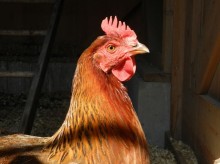When a respiratory disease shows up in a flock, it hits hard and fast. Within days of one hen showing symptoms, many of your other chickens will, too. There are a variety of respiratory ailments caused by numerous bacteria and viruses, but the tell-tale signs are similar for all of them. Eyes bubble with mucus, or blink shut with exhaustion, chickens struggle to breathe, and they hunch up, listless. and weak. Left untreated, many of your chickens will die. It’s no wonder that farmers who make their living from their animals cull at the first hint of illness. No one wants to see death rampage through their flock. However, for the backyard chicken keeper, there are other ways to deal with respiratory disease.
I once brought home a lovely Rhode Island Red pullet. Within days, all of my other hens came down with a respiratory disease caused by the bacterium, Mycoplasma gallisepticum, (MG.) The bacteria which causes MG is an odd creature; it lacks a cell wall. That means that it is fragile when it is outside of the birds and can be killed with heat, sunlight, disinfectants, or simply time – after 3 days, it dies. But, inside the birds, it is virulent and can lead to severe respiratory disease. My chickens became so sick, and their eyes so crusted, that they couldn’t see to eat. Meanwhile, my new Rhode Island Red looked fine – a hen can look perfectly healthy, but still be carrier of MG (which is another reason why for many farmers it’s and economic necessity to destroy an entire flock when the first hint of illness appears.)
Fortunately, there are drugs that work. Three days on Tylan (an antibiotic), and some terramycin squirted in the eyes, and all were back to normal. Although these hens might now be carriers, I’ve never had another attack of MG, even when new birds have joined the flock.
My hens have suffered from other bouts with other forms of respiratory illness, too. The symptoms vary, but all have similarities showing raspy, tired breathing. Unless you do a blood test, you’ll never know exactly what your birds have, but, that doesn’t matter, since treatment remains the same for any respiratory disease.
The first line of defense is that when you see a hen that you suspect is ill, isolate her and observe. If she has respiratory symptoms, then you might want to medicate. If only one hen is showing symptoms, isolate her and treat. If any of the other hens look even a tad off, I’d put antibiotics in their water, too.
Avian antibiotics are available at feed stores and on-line.Tetracycline is a broad-spectrum antibiotics and usually knocks out any bug that your flock has. It can be bought on-line or in your local feed store. It’s good to have some on hand. Follow the dosage directions carefully. The drugs are packaged for huge flocks, so to get the dose right for a few hens, I use a digital kitchen scale. Usually, you’ll dilute it in water and dose them through their water font. However, your sickest hens might not be drinking. Use an eye dropper or a syringe to pour the medicated water down the hen’s throat. Tylan is a powerful drug, and more specific for severe cases and MG. Tylan might come in pill form, which makes it easy to give to an individual hen, but not so nice when you have a dozen or more hens to medicate!
Continue to medicate according to package directions. The ailment will return if you stop dosing before the advised number of days. You’ll have to discard eggs that were laid while the hens were on antibiotics. I’ve read recommendations to throw out eggs up to ten days after the last dose.
I buy meat from farms that raise animals without antibiotics. I’m against feeding sub-therapeutic drugs just so that animals can survive in stressful housing. But, I’m grateful that I can use these drugs when my animals are ill!

